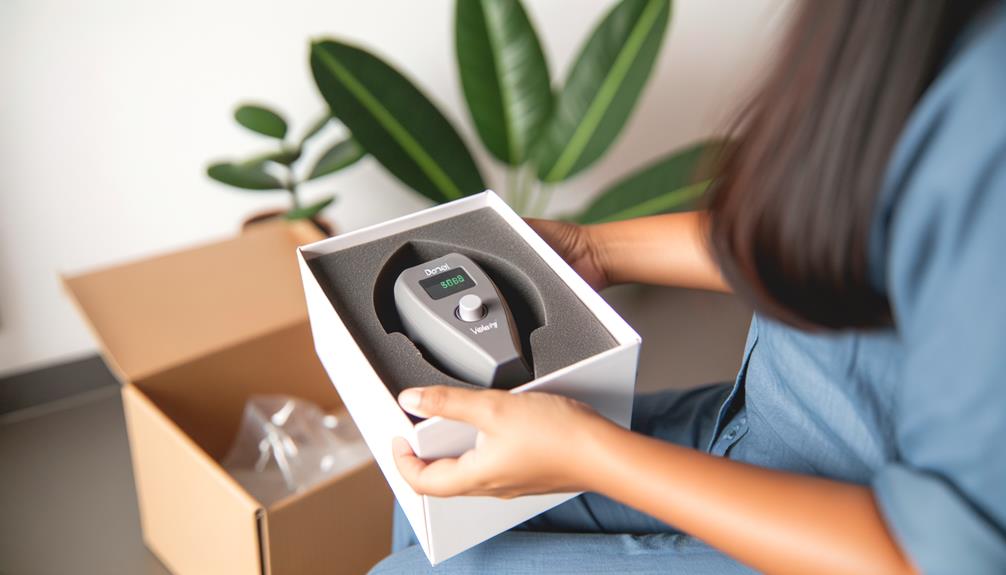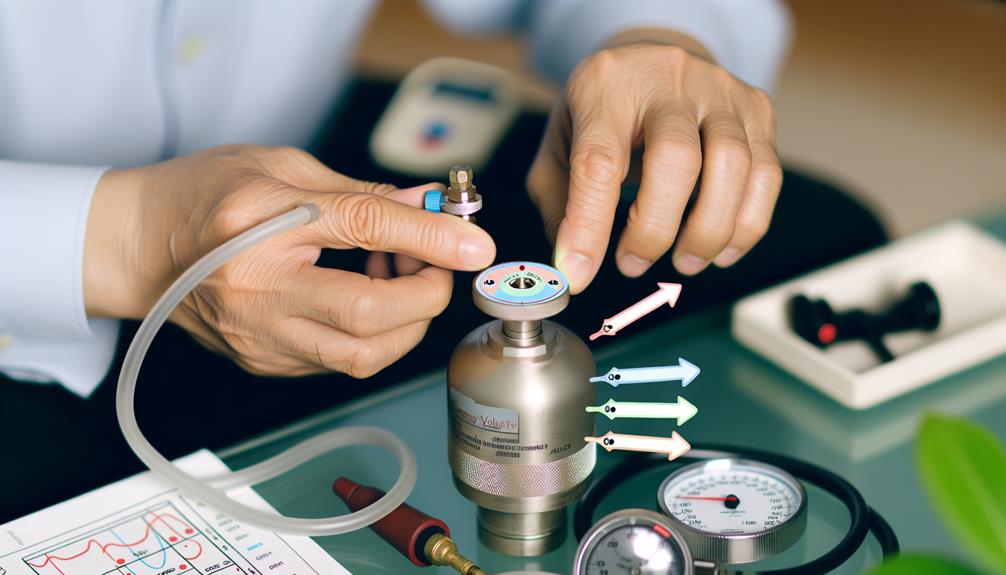10 Steps to Use the Bonsai Velocity Oxygen Regulator
The Bonsai Velocity Oxygen Regulator requires initial inspection for packaging damage and component completeness. Handle the regulator with clean hands, ensuring all connections are secure.
Adjust the flow using the Flow Adjustment Knob, and monitor pressure via the Pressure Gauge. Adhere strictly to safety measures, including emergency shut-off procedures and regular inspections.
Maintain the regulator by keeping it free from contaminants and storing it in a clean, dry environment. Regular maintenance and understanding troubleshooting steps are essential for best performance.
For a thorough understanding of handling and operational details, further insights are available.

Key Takeaways
- Inspect the regulator for defects and ensure all components are present before use.
- Securely attach the regulator to the oxygen source using the outlet connection.
- Adjust the flow using the Flow Adjustment Knob for precise regulation.
- Monitor tank pressure using the Pressure Gauge for real-time data.
- Regularly inspect and document examination results in a logbook for safety and maintenance.
Unboxing Your Regulator

Upon receiving your Bonsai Velocity Oxygen Regulator, carefully inspect the packaging for any signs of damage. If the packaging appears compromised, document the condition and contact the supplier immediately for further instructions.
Open the package and remove the regulator, ensuring to handle it with clean hands to maintain sterility. Confirm that all included components, such as the user manual, are present. Examine the regulator for any physical defects or abnormalities, including cracks or loose parts. If any issues are detected, refrain from using the device and seek professional assistance.
Store the regulator in a clean, dry environment until it is ready for use. Proper initial inspection guarantees the device's functionality and safety in subsequent applications.
Understanding Key Components
A thorough understanding of the key components of the Bonsai Velocity Oxygen Regulator is necessary for ensuring its best performance and safe operation. This device comprises several critical parts, each playing a crucial role in its functionality:
- Flow Adjustment Knob: This allows the user to regulate the oxygen flow rate precisely, ensuring the correct therapeutic dosage.
- Pressure Gauge: This shows the pressure level of the oxygen tank, allowing for continuous monitoring to prevent over- or under-pressurization.
- Outlet Connection: This port connects the regulator to the oxygen delivery system, ensuring a secure attachment and consistent oxygen flow.
Safety Precautions

When utilizing the Bonsai Velocity Oxygen Regulator, adherence to safety precautions is crucial. Proper handling techniques must be observed, and the equipment should be inspected regularly to maximize functionality.
Additionally, users should be thoroughly familiar with emergency shut-off procedures to mitigate any potential hazards.
Proper Handling Techniques
To guarantee the safe operation of the Bonsai Velocity Oxygen Regulator necessitates adherence to strict handling protocols.
To mitigate risks and ensure peak performance, consider the following guidelines:
- Avoid Contaminants: Keep the regulator free from oils, grease, and other pollutants. These substances can react with oxygen, posing a significant fire hazard.
- Secure Connections: Confirm all connections are tight and secure before activating the regulator. Loose connections can lead to oxygen leakage, increasing the risk of combustion.
- Controlled Environment: Operate the regulator in a well-ventilated area, away from open flames and flammable materials. Oxygen-enriched environments can exacerbate fire risks.
Inspect Equipment Regularly
Regular examination of the Bonsai Velocity Oxygen Regulator is crucial to identify potential wear, damage, or malfunction that could compromise safety. Conduct visual and tactile inspections before each use, focusing on the integrity of connections, hoses, and the regulator body. Confirm that there are no visible cracks or deformities.
Inspect all seals and gaskets for signs of deterioration. Verify the accuracy of pressure readings using a calibrated gauge, making sure they fall within specified operational parameters. Clean the regulator regularly to prevent dust and debris accumulation, which can hinder functionality.
Record examination results and maintenance actions meticulously in a logbook. Following these protocols guarantees the reliable performance and longevity of the equipment, thereby protecting user safety.
Emergency Shut-off Procedures
In the event of a malfunction or emergency, immediate shut-down procedures must be clearly understood and executed to guarantee user safety. Proper adherence to these procedures minimizes potential hazards and secures the integrity of the equipment.
Follow these steps to perform an emergency shut-down:
- Turn Off the Regulator: Rotate the control knob clockwise to the 'off' position. This action stops oxygen flow instantly.
- Disconnect the Regulator: Carefully detach the regulator from the oxygen source, securing no further gas escape.
- Inspect for Leaks: Conduct a thorough inspection for any visible or audible leaks and secure the area is safe before taking further action.
Understanding and practicing these steps is critical for maintaining safety and equipment functionality in emergencies.
Connecting the Regulator
To connect the Bonsai Velocity Oxygen Regulator, first confirm that the oxygen cylinder valve is closed securely.
Next, inspect the regulator for any signs of damage or contamination.
Align the regulator's inlet connection with the cylinder's outlet valve.
Firmly screw the regulator onto the cylinder valve by rotating it clockwise until it is hand-tight.
Verify that the regulator is correctly seated and that there are no visible gaps between the regulator and the cylinder.
Once secure, use an appropriate tool to slightly tighten the connection further, making sure it is leak-proof but not overtightened.
Confirm that all components are secure before proceeding to the next steps in the setup process. This ensures the safe and efficient operation of the oxygen delivery system.
Adjusting Oxygen Flow

Precisely adjusting the oxygen flow is essential for guaranteeing accurate delivery to the patient. To achieve this, follow these steps:
- Set the Flow Rate:
Turn the flow control knob to the prescribed flow rate, typically measured in liters per minute (LPM). Verify the setting visually to ensure precision.
- Monitor the Output:
Observe the flow indicator to confirm the regulator is providing the appropriate amount of oxygen. The flow should match the prescribed rate without fluctuation.
- Check for Leaks:
Inspect all connections and tubing for any signs of leaks or kinks which could hinder the flow. Use soapy water to detect leaks if necessary, as bubbles will form at leak sites.
Adherence to these steps guarantees precise and reliable oxygen delivery.
Using the Pulse Dose Setting
Utilizing the pulse dose setting is a method designed to optimize oxygen delivery by providing bursts of oxygen only during inhalation. This system guarantees efficient use of oxygen, reducing waste and extending the duration of the oxygen supply.
To activate the pulse dose setting, rotate the regulator's dial to the desired pulse dose number. The Bonsai Velocity Oxygen Regulator detects the patient's inhalation through a sensitive sensor, triggering a precise, metered dose of oxygen.
This setting is particularly beneficial for ambulatory patients, as it allows for greater mobility by conserving oxygen. Confirm the nasal cannula is properly positioned for accurate detection of inhalation and effective delivery of oxygen.
Proper use enhances therapeutic outcomes and conserves valuable oxygen resources.
Monitoring Oxygen Levels
Monitoring oxygen levels with the Bonsai Velocity Oxygen Regulator involves precise adjustments to flow settings and accurate interpretation of display indicators.
Achieving the correct flow rate is essential for best therapeutic outcomes.
Regularly checking the device's display guarantees that oxygen delivery stays within prescribed parameters.
Adjusting Flow Settings
To adjust the flow settings on the Bonsai Velocity Oxygen Regulator, start by turning the dial to the preferred flow rate while attentively observing the corresponding oxygen levels indicated on the device. This process guarantees that the patient receives the accurate amount of oxygen prescribed.
Follow these steps:
- Select Flow Rate: Rotate the dial to the suitable flow rate as directed by the healthcare provider.
- Monitor Readings: Continuously check the oxygen levels displayed on the regulator to confirm the correct dosage.
- Confirm Stability: Maintain the chosen setting and observe for consistent oxygen delivery over a specified period.
Reading Display Indicators
Accurately interpreting the display indicators on the Bonsai Velocity Oxygen Regulator is important for achieving appropriate oxygen delivery to the patient. The digital display provides real-time data on oxygen flow rates and pressure, allowing clinicians to monitor and adjust settings as needed.
Key indicators include the flow rate, typically measured in liters per minute (LPM), and the pressure gauge, which guarantees the system operates within safe parameters. An alarm system may activate under specific conditions such as low battery or irregular oxygen flow, prompting immediate attention.
Regularly reviewing these indicators ensures best performance and safety, providing a reliable means to meet patient-specific oxygen requirements. Proper interpretation of these parameters is vital for effective respiratory therapy management.
Cleaning the Regulator
Regular cleaning of the Bonsai Velocity Oxygen Regulator is important to secure peak performance and longevity. Follow these precise steps:
- Disassemble the Regulator: Carefully disconnect the regulator from the oxygen source. Remove any detachable components, taking note of their arrangement for reassembly.
- Clean the Components: Use a lint-free cloth dampened with a mild, non-abrasive soap solution. Gently wipe each part to remove dust, debris, and any accumulated residues. Secure no liquid enters internal mechanisms.
- Dry and Reassemble: Thoroughly dry each component with a clean, dry cloth. Reassemble the regulator by following the disassembly steps in reverse order. Secure all parts are securely and correctly positioned.
Adhering to this cleaning protocol maintains the regulator's functionality and extends its service life.
Troubleshooting Common Issues

Identifying and addressing common issues with the Bonsai Velocity Oxygen Regulator guarantees uninterrupted and efficient operation.
A prevalent issue is leakage, often due to improperly seated connections or defective O-rings. Confirm all fittings are tightly secured and replace damaged O-rings promptly.
Another common problem is inaccurate flow rates, which may result from obstructions or debris within the regulator. Regular cleaning and inspection of the internal components are recommended to maintain precise functionality.
Additionally, irregular oxygen delivery can occur if the battery is depleted or malfunctioning. Verify battery charge and replace as necessary.
For any persistent issues, consult the manufacturer's guidelines or seek professional maintenance to make sure the device operates within its specified parameters.
Storing the Regulator
Proper storage of the Bonsai Velocity Oxygen Regulator is essential for maintaining its longevity and guaranteeing it remains in peak working condition. To store the regulator correctly, adhere to the following guidelines:
- Clean and Dry: Make sure the regulator is thoroughly cleaned and completely dry before storage. Moisture can lead to corrosion and compromise functionality.
- Protective Environment: Store the regulator in a cool, dry place, away from direct sunlight and extreme temperatures. Avoid humid environments which can degrade the materials.
- Avoid Physical Stress: Place the regulator in a padded container or case to prevent physical damage. Guarantee it is not subjected to heavy weights or pressures that could deform or damage the device.
These steps will help preserve the regulator's effectiveness and reliability.
Regular Maintenance Tips
Regular maintenance of the Bonsai Velocity Oxygen Regulator is essential to guarantee peak performance and safety. Inspect the regulator regularly for any signs of wear, damage, or leaks. Clean the exterior with a soft cloth and mild detergent to prevent dust accumulation. Make sure the filters are free from obstructions and replace them as suggested by the manufacturer. Lubricate moving parts with an approved lubricant to reduce friction and wear.
| Maintenance Task | Frequency |
|---|---|
| Inspect for wear or damage | Weekly |
| Clean exterior | Monthly |
| Replace filters | As recommended |
Performing these maintenance tasks systematically will extend the lifespan of the regulator, ensuring dependable and safe oxygen delivery. Always refer to the user manual for specific maintenance guidelines and safety instructions.
Conclusion
The correct use and maintenance of the Bonsai Velocity Oxygen Regulator guarantee efficient and safe oxygen delivery, much like a well-tuned engine drives a car smoothly.
Adhering to guidelines for unboxing, connecting, adjusting, and cleaning the regulator reduces risks and prolongs its lifespan.
Regular maintenance and troubleshooting are essential practices that safeguard against operational failures, ensuring consistent performance.
Adopting these protocols promotes peak functionality and enhances user safety, thereby reinforcing the device's reliability.



